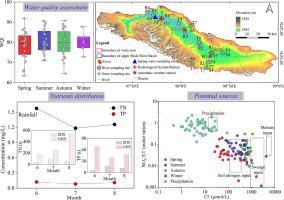Distribution, assessment, and sources of nutrients in river water in the headwaters of the Shule River Basin, Northeastern Qinghai-Tibet Plateau
IF 6.3
2区 环境科学与生态学
Q1 ENVIRONMENTAL SCIENCES
引用次数: 0
Abstract
Nitrogen (N) and phosphorus (P) are essential nutrients and can significantly impact primary productivity of the ecosystem causing water environmental problems. However, their cycling mechanisms are not well understood in alpine mountains with climate change. Hence, 94 samples of river water were collected from 2018 to 2020 in the headwaters of the Shule River Basin to assess the nutrients spatiotemporal distribution and combined approach of water quality index to assess water quality and potential sources. The findings depict that high nutrient concentrations were found to coincide with snowmelt and glacial meltwater and rainfall recharge periods, while total flux peaked from June to September due to increased runoff. Notably, total nitrogen (TN) concentrations were significantly higher near the town, primarily attributed to the replenishment of nitrate (NO3‒-N) from livestock manure. The high total P (TP) was near the glacier, which was attributed to the transportation of glacial sediments into the river, and pH was another critical factor. N was the primary nutrient limiting factor for the growth of phytoplankton in river water. Although the migration and transport of nutrients have altered with climate change, river water quality is good in alpine mountains based on an overall evaluation. These findings contribute to enriching nutrient datasets and highlight the importance of water resource management and water quality assessment in sensitive and fragile alpine mountains.

青藏高原东北部疏勒河源区河水营养成分分布、评价及来源
氮(N)和磷(P)是生态系统必需的营养物质,对生态系统的初级生产力有重要影响,导致水环境问题。然而,在气候变化的高寒山区,它们的循环机制尚不清楚。基于此,本研究于2018 - 2020年在疏勒河流域的源头采集了94份河流水质样本,对其养分时空分布进行了评价,并采用水质指数联合评价方法对水质和潜在水源进行了评价。研究结果表明,高营养物浓度与融雪和冰川融水以及降雨补给期相吻合,而由于径流增加,总通量在6月至9月达到峰值。总氮(TN)浓度在城镇附近显著升高,这主要是由于畜禽粪便补充了硝态氮(NO3—N)。高总磷(TP)分布在冰川附近,这与冰川沉积物向河流输送有关,pH值是另一个关键因素。氮是河水浮游植物生长的主要营养限制因子。虽然营养物质的迁移和运输随气候变化而改变,但综合评价,高寒山区河流水质较好。这些发现有助于丰富营养数据集,并突出了敏感脆弱高山水资源管理和水质评估的重要性。
本文章由计算机程序翻译,如有差异,请以英文原文为准。
求助全文
约1分钟内获得全文
求助全文
来源期刊

Journal of Environmental Sciences-china
环境科学-环境科学
CiteScore
13.70
自引率
0.00%
发文量
6354
审稿时长
2.6 months
期刊介绍:
The Journal of Environmental Sciences is an international journal started in 1989. The journal is devoted to publish original, peer-reviewed research papers on main aspects of environmental sciences, such as environmental chemistry, environmental biology, ecology, geosciences and environmental physics. Appropriate subjects include basic and applied research on atmospheric, terrestrial and aquatic environments, pollution control and abatement technology, conservation of natural resources, environmental health and toxicology. Announcements of international environmental science meetings and other recent information are also included.
 求助内容:
求助内容: 应助结果提醒方式:
应助结果提醒方式:


